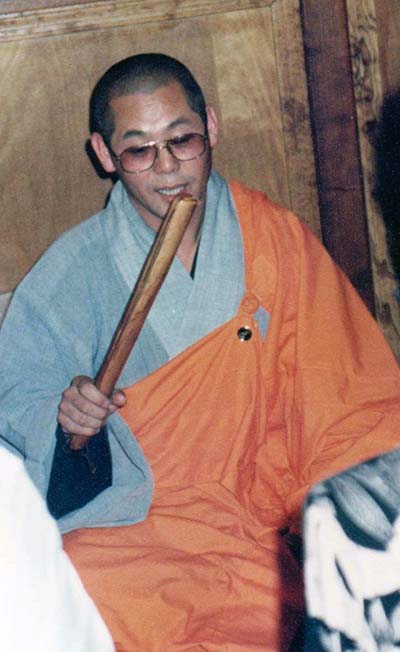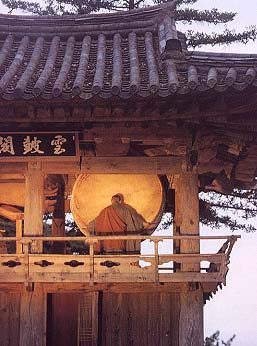
In the Dhamma Stories section you will find a series of excerpts from Dhamma talks.
They convey various Buddhist concepts and understandings in story form.
The wake-up stick
By Helen Jandamit
Located almost at the summit of the mountain in Kwan Ju, South Korea, the Soen [Zen] monks (Bhikkhus) and Lady monks (Bkikkhunis) at Hua Om Sa Temple woke hours before dawn to the sound of a bell or sometimes a wooden clapper being sounded near their sleeping quarters.
Typically, the wake-up call would come at 3 am.
In the chilled darkness of early morning, the Bhikkhus and Bhikkhunis would pull on their outer robes and make their way to their respective gathering places for morning chanting and meditation.
|
 |
The monitor monk and his wake-up stick.
'In the Buddhist tradition, maintaining a tight but not intolerable discipline is expected in temples. The Middle Way, Majjhimā Paṭipadā in the ancient Pali language, is the term that Siddhartha Gautama used to describe the character of the path he had discovered that leads to liberation.' Wikipedia
The Middle Way is sustainable, whereas extreme practices are not. According to the Pali Canon of Theravada Buddhism, the expression 'The Middle Way' was used by the Buddha in his first discourse (the Dhammacakkappavattana Sutta) to preface his teachings and to describe the Noble Eightfold Path as a path that lies between the extremes of austerity and sensual indulgence. This is the meaning that I am focusing on here.
Given our different backgrounds and preferences, one man’s middle way may be very difficult for another to follow. Waking up three hours after midnight and walking through the cold darkness to the main hall to meditate is not the easiest thing for many people to do, and at 3 am, many of the monks at Hua Om Sa were still sleepy and they sometimes dozed off during the morning meditation group session.
This is when the monitor monk became so important. In the spacious high-ceilinged wooden hall, with the colourfully-painted interlocked beams barely visible above him in the candle light, the monitor monk walks up and down the neat rows of meditators. He is wearing baggy, grey pyjama-like robes and carrying a double-layered polished wooden tube about two feet long and one and a half inches wide. This unique instrument is used to awaken sleeping meditators. It is hollow. The outer layer is incised with long slits cut along the length of the tube. The inner layer does not have these slits. If you hit the tube against something, it emits a resounding ‘crack’.
The monitor monk’s job is to notice anyone who appears to be about to fall asleep and to hit him from the back across his shoulders. The slits in the wood ensure that the blow will produce a reverberating whack but not cause any major physical damage. The shock of the blow ensures that the sleepy meditator is very unlikely to fall asleep again any time soon during formal meditation.
A monitor monk is highly respected. His job is to be the awakener. Formerly-sleepy meditators come to him after the session to thank him and to pay him respect.
Crocodile pools
Zen, famously (in Western movies at least) sets up situations where fear would keep people
awake. These included meditating on a ledge at the top of a cliff or on a rooftop. Another anecdotal keep-awake scenario was to meditate on or walk across a narrow plank thrown
across a pool containing crocodiles.
When we perceive an imminent threat, our system gets a shot of adrenaline. Our senses become heightened and focus is directed to the ongoing situation. We seek a way to escape the danger or somehow deflect it. When that sense of heightened presence is directed to interactions in the ordinary world, even a simple act of opening a door can become a life-changing experience.
It is only in the present that a person can be fully-engaged. Someone who is fully-engaged is awake to the present.
|
|
 |
|
Quotes
A brahmin once asked the Blessed One:
"Are you a God?"
"No, brahmin" said the Blessed One.
"Are you a saint?"
"No, brahmin" said the Blessed One.
"Are you a magician?"
"No, brahmin" said the Blessed One.
"What are you then?"
"I am awake."
You can't wake a person who is pretending to be asleep.
Navajo Proverb
|
Back to the first story page
For more information
Phone: + 66 2511-0439 (From outside Thailand) or 02-511-0439 (within Thailand)




